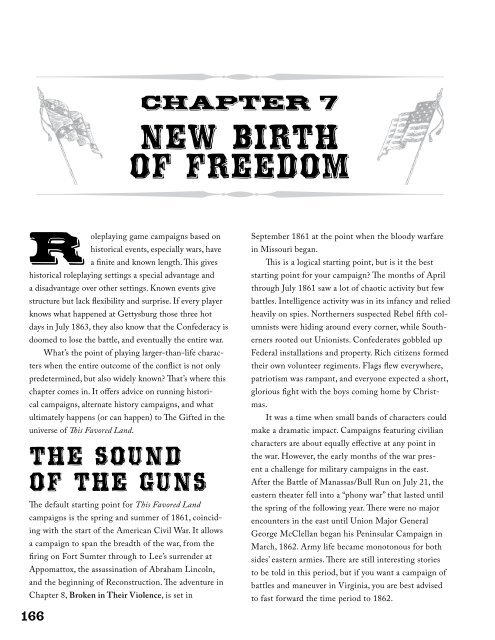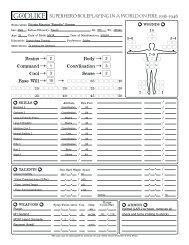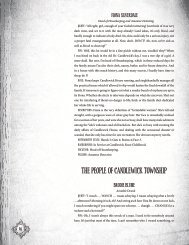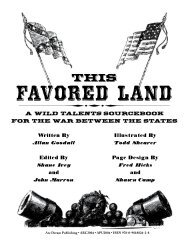new birth of freedom - Arc Dream Publishing
new birth of freedom - Arc Dream Publishing
new birth of freedom - Arc Dream Publishing
You also want an ePaper? Increase the reach of your titles
YUMPU automatically turns print PDFs into web optimized ePapers that Google loves.
Roleplaying game campaigns based on<br />
historical events, especially wars, have<br />
a fi nite and known length. Th is gives<br />
historical roleplaying settings a special advantage and<br />
a disadvantage over other settings. Known events give<br />
structure but lack fl exibility and surprise. If every player<br />
knows what happened at Gettysburg those three hot<br />
days in July 1863, they also know that the Confederacy is<br />
doomed to lose the battle, and eventually the entire war.<br />
What’s the point <strong>of</strong> playing larger-than-life characters<br />
when the entire outcome <strong>of</strong> the confl ict is not only<br />
predetermined, but also widely known? Th at’s where this<br />
chapter comes in. It <strong>of</strong>f ers advice on running historical<br />
campaigns, alternate history campaigns, and what<br />
ultimately happens (or can happen) to Th e Gifted in the<br />
universe <strong>of</strong> is Favored Land.<br />
The Sound<br />
<strong>of</strong> the Guns<br />
Th e default starting point for This Favored Land<br />
campaigns is the spring and summer <strong>of</strong> 1861, coinciding<br />
with the start <strong>of</strong> the American Civil War. It allows<br />
a campaign to span the breadth <strong>of</strong> the war, from the<br />
fi ring on Fort Sumter through to Lee’s surrender at<br />
Appomattox, the assassination <strong>of</strong> Abraham Lincoln,<br />
and the beginning <strong>of</strong> Reconstruction. Th e adventure in<br />
Chapter 8, Broken in Their Violence, is set in<br />
166<br />
Chapter 7<br />
<strong>new</strong> <strong>birth</strong><br />
<strong>of</strong> <strong>freedom</strong><br />
September 1861 at the point when the bloody warfare<br />
in Missouri began.<br />
Th is is a logical starting point, but is it the best<br />
starting point for your campaign? Th e months <strong>of</strong> April<br />
through July 1861 saw a lot <strong>of</strong> chaotic activity but few<br />
battles. Intelligence activity was in its infancy and relied<br />
heavily on spies. Northerners suspected Rebel fi fth columnists<br />
were hiding around every corner, while Southerners<br />
rooted out Unionists. Confederates gobbled up<br />
Federal installations and property. Rich citizens formed<br />
their own volunteer regiments. Flags fl ew everywhere,<br />
patriotism was rampant, and everyone expected a short,<br />
glorious fi ght with the boys coming home by Christmas.<br />
It was a time when small bands <strong>of</strong> characters could<br />
make a dramatic impact. Campaigns featuring civilian<br />
characters are about equally eff ective at any point in<br />
the war. However, the early months <strong>of</strong> the war present<br />
a challenge for military campaigns in the east.<br />
After the Battle <strong>of</strong> Manassas/Bull Run on July 21, the<br />
eastern theater fell into a “phony war” that lasted until<br />
the spring <strong>of</strong> the following year. Th ere were no major<br />
encounters in the east until Union Major General<br />
George McClellan began his Peninsular Campaign in<br />
March, 1862. Army life became monotonous for both<br />
sides’ eastern armies. Th ere are still interesting stories<br />
to be told in this period, but if you want a campaign <strong>of</strong><br />
battles and maneuver in Virginia, you are best advised<br />
to fast forward the time period to 1862.
After the start <strong>of</strong> the Peninsular Campaign, virtually<br />
all <strong>of</strong> Virginia was in a near constant state <strong>of</strong> war. The<br />
town <strong>of</strong> Winchester in the Shenandoah Valley changed<br />
hands more than 70 times, with six significant battles (at<br />
least 10,000 troops engaged) fought in the town and its<br />
vicinity. The only respite given the state was Lee’s inva-<br />
sion <strong>of</strong> Maryland in the summer <strong>of</strong> 1862 and his invasion<br />
<strong>of</strong> Pennsylvania in the summer <strong>of</strong> 1863. The capitals <strong>of</strong><br />
the two belligerents (Washington D.C. and Richmond,<br />
Virginia) were only 110 miles apart. More major and<br />
minor battles were fought in this state than in any other.<br />
Virginia was the most populated Southern state. If you<br />
can’t come up with ways to run a campaign set in Vir-<br />
ginia, you should reconsider the Civil War as a setting!<br />
The war in the western theater was just as heav-<br />
ily contested as Virginia, but the conflict ranged over<br />
hundreds <strong>of</strong> miles <strong>of</strong> territory. While characters living<br />
in Virginia can afford to let the war come to them, this<br />
is not the case with characters living in the west. The<br />
first major battle in the west was Wilson’s Creek in<br />
August 1861 in southern Missouri. Within a year the<br />
war reached as far south as the Gulf coast, as far west<br />
as New Mexico; New Orleans, the jewel <strong>of</strong> the Confed-<br />
eracy, was in Union hands.<br />
The west was actually divided into two sections.<br />
The “western theater” typically covers the war west<br />
<strong>of</strong> the Allegheny Mountains and east <strong>of</strong> the Missis-<br />
sippi River. Sherman’s march through Georgia and the<br />
Carolinas in 1864 and 1865 is considered a “western<br />
campaign” mainly because the Army <strong>of</strong> the Tennessee<br />
was a western army.<br />
West <strong>of</strong> the Mississippi River was the Department<br />
<strong>of</strong> the Trans-Mississippi. Although the largest section<br />
<strong>of</strong> the war in area, it was the least populated. In many<br />
ways it’s also the most interesting part <strong>of</strong> the war. It<br />
covers the bloody, contested ground <strong>of</strong> Missouri, the<br />
Indian territories (where some ex-Confederates fought<br />
as members <strong>of</strong> the regular Union army against the na-<br />
tives), and the isolated Confederate states <strong>of</strong> Arkansas,<br />
Louisiana, and Texas. Arkansas and Louisiana were<br />
divided for most <strong>of</strong> the war, with the Union occupying<br />
northern Arkansas and southern Louisiana. This section<br />
<strong>of</strong> the country (as well as West Virginia and Kentucky)<br />
Chapter 7: New Birth <strong>of</strong> Freedom<br />
saw a lot <strong>of</strong> irregular warfare between rangers, partisans,<br />
and guerrillas. The fighting in Missouri was particularly<br />
vicious (see Chapter 8).<br />
There are plenty <strong>of</strong> military adventure opportuni-<br />
ties in the west, but civilian campaigns in a static loca-<br />
tion will usually see the war flare up briefly, and then<br />
disappear almost as quickly. The exceptions are the<br />
Southern cities occupied by Union forces for most <strong>of</strong><br />
the war (such as New Orleans, Memphis, and Nash-<br />
ville) and the bloody border war in Kansas, Missouri,<br />
and northern Arkansas.<br />
Location, Location,<br />
Location<br />
When most people think <strong>of</strong> the Civil War, they think<br />
<strong>of</strong> the corridor from Virginia through southern Penn-<br />
sylvania. In actuality, the war was fought as far north<br />
as Vermont, as far south as Florida and as far west as<br />
Oregon. Confederate commerce raiding occurred all<br />
over the globe. While a great many important battles<br />
happened in Virginia, there was a lot more to the Civil<br />
War. Here are just some less obvious locales for your<br />
Civil War campaigns.<br />
Missouri: Missouri remained <strong>of</strong>ficially a north-<br />
ern state throughout the war, but it was also a slave<br />
state with strong Confederate sympathies. Pro-slavery<br />
Missourians had tried to influence the Kansas state<br />
constitution in a violent antebellum conflict known<br />
as “Bleeding Kansas.” When the war began, Kansas<br />
Jayhawkers saw an opportunity for revenge. The result<br />
was a horrible guerrilla war where murder and terrorism<br />
were common. Missouri is the most interesting state<br />
for a guerrilla war-themed campaign, as the war lasted<br />
there well into 1866 and spawned numerous Wild West<br />
legends, such as Jesse James and the Youngers.<br />
Appalachian Mountains: While Missouri’s guer-<br />
rilla conflict may be the most famous <strong>of</strong> the war, it was<br />
not alone. Union and Confederate guerrillas operated<br />
in the Appalachian Mountains from West Virginia<br />
down to South Carolina. Both sides famously used the<br />
mountain’s valleys for military operations in Virginia<br />
and Tennessee, but the irregular warfare in the moun-<br />
tains is less well known.<br />
167















